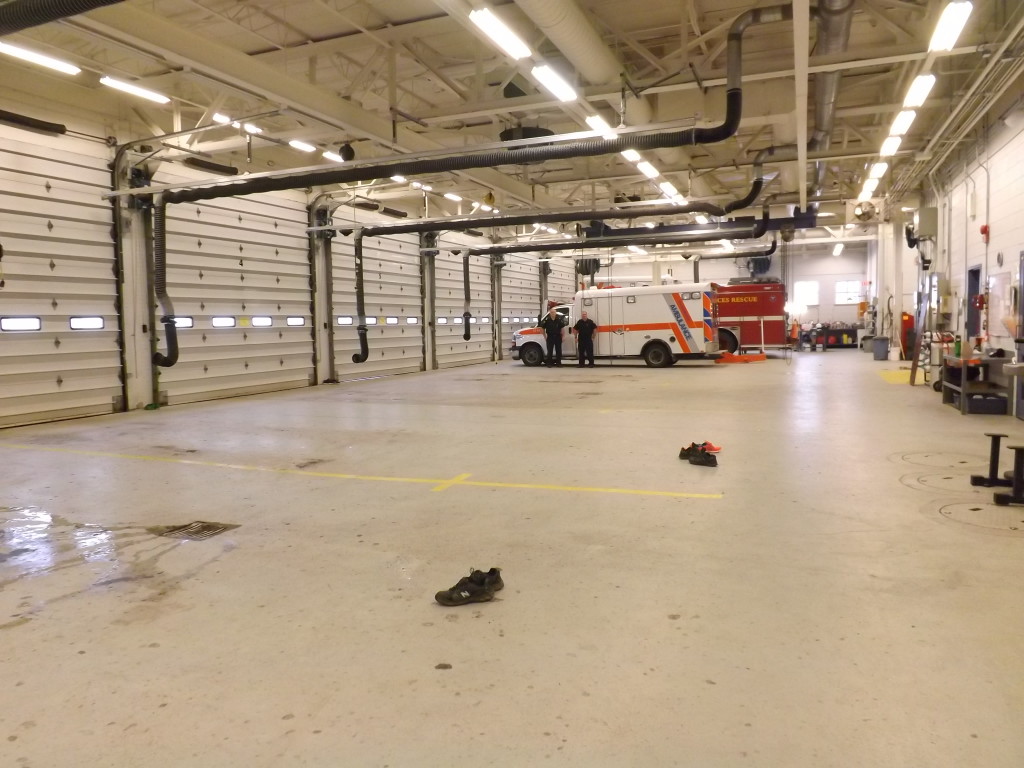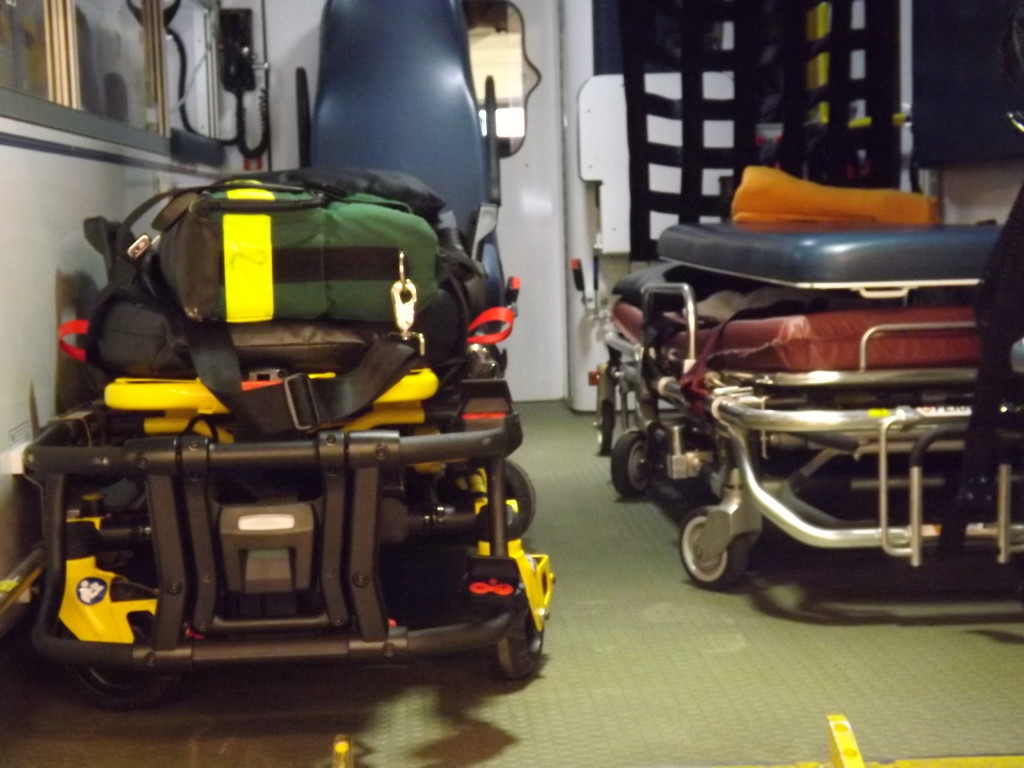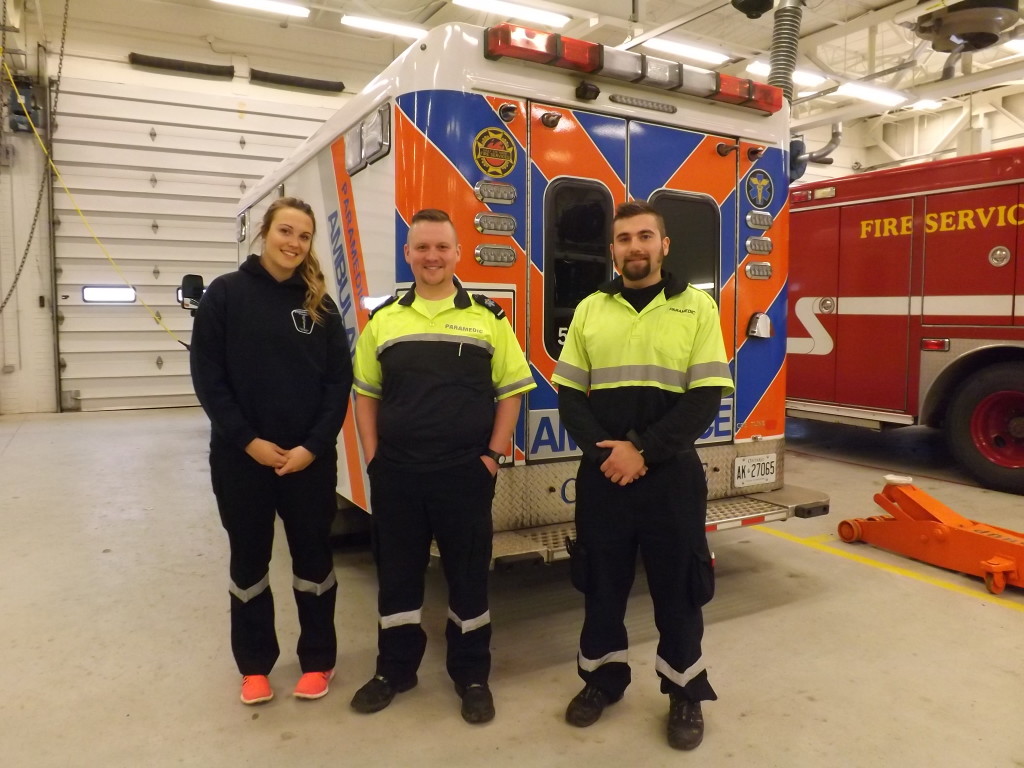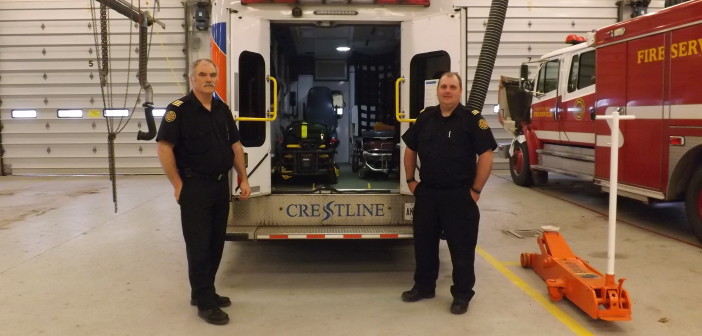They’re not pumping out daily updates to the media and they’re not posing shirtless whilst holding an ax for a calendar but they are saving lives every day. They’re often the first on scene and the first to leave long before the media shows up to snap the dramatic shot of police cars and fire trucks flanking a couple of cracked up cars for the front page. You’re not likely to hear about their life saving actions that make up the daily grind. The Personal Health Information Privacy Protection Act prohibits that sort of boasting. But there they are, every day slogging through the unglamorous accoutrements of their calling- blood, guts, puke, human waste, phlegm and eyefuls of every depressing human condition known to man.
They are paramedics, the invisible heroes among first responders.
Rob Rushworth, manager of the Emergency Medical Service Division with Sault Ste. Marie Fire Services remarks of the profession, “It’s a very dynamic workplace and I think that’s part of the attraction to the job. You never know what is going to happen. There is no set schedule. The rule in EMS is don’t make plans after work- there’s no stopping in the middle of a medical call 50 kilometers from the hospital.”
“Our staff are medical professionals,” adds Jeff Bowen, Manager of Quality Assurance. “They are paramedics, not ambulance drivers. They are continuously learning and upgrading their skills. They perform life-saving interventions everyday but we are unfortunately not in a position to discuss those events.”
Both Rushworth and Bowen have put in time on the frontlines. Rushworth has been with the service for 25 years and prior to serving in his current position worked as a paramedic for 13 years. Bowen started on the frontlines as a paramedic in 2003 and moved into his current role in 2010.
After being downloaded to the City from the Sault Area Hospital in 2002 EMS services held the status quo until 2010 when the first significant enhancement was made to the operations.
2002: Ambulance services are downloaded to the City of Sault Ste. Marie. Service runs with 3 ambulances on the road 24 hours a day, seven days a week. The service covers the Sault Ste. Marie District- a catchment that encompasses 44,000 sq. kilometers. The District extends east towards until it meets with St. Joseph Island ambulance services (68 km from base) and north to Montreal River (182 km from base).
2010: The Ministry of Health proposes opening a small base in Garden River during the day. The District of Sault Ste. Marie Administration Board and the City of Sault Ste. Marie agree to maintain City paramedics at the base. A 2 man crew is added to the day shift in Garden River. The enhancement provides 1 additional ambulance, entirely funded by the Federal government, on the road for a 12 hour day shift. The Sault District is now served by 4 ambulances during the day and 3 ambulances during the night.
June 2015: Sault Ste. Marie Emergency Medical Services (SSM EMS) propose a pilot that would add another ambulance to the day shift in the Sault District.
June 30, 2015: An additional crew is added to the day shift raising the fleet number to 5 ambulances running in the Sault District during the day and maintaining 3 ambulances in the district throughout the night. The addition allows paramedics to anticipate a lunch break at some point during their 12 hour shift and make it back to base to complete paperwork between calls.
May 2015: SSM EMS present a case to the Ministry of Health supporting the need to provide a night shift on the Garden River base.
November 12, 2015: A night shift is instated on the Garden River base. The additional crew provides for 4 ambulances on the road at night and the daytime fleet remains status quo at 5 ambulances serving the Sault District during the 12 hour day shifts. The 12 hour evening ambulance and crew in Garden River is entirely funded by the province.
The recent increase in ambulances to the SSM District fleet is long overdue. It is not uncommon that call volume exceeds resource capacity- in other words there aren’t enough paramedics working to respond to emergency needs. The addition of two day trucks and an evening truck does alleviate the burden of this occurrence however.
“There are still times when ambulances might not be available or delayed- but it’s becoming rarer. We’re finally getting on top of it after 13 years. There’s finally steps forward that address the volume of calls,” remarks Rushworth.

Rushworth (left) and Bowen (right) stand in front of the ’emergency’ ambulance in the empty bay. All paramedic crews are off base and out on calls.
So what happens when every paramedic team is out on a call and there’s nobody left at base? It might horrify Saultites to know.
Should an emergency call come in when all scheduled paramedics are attending calls, base staff jump on the phone and try to find a couple of off-duty paramedics to come in to respond to the emergency. If someone (or some two) is able to come in- they must dress in uniform, get into their personal vehicle and drive civilian speed from wherever they live to the base, hop in the ambulance and then head to the call.
In 2010 EMS services picked up about 7,000 calls. By the end of 2015 it is projected that SSM EMS will have received around 12,750 which averages out to about 35 calls in the SSM District per day. The increase in call volume is open to speculation- perhaps an increase in an elderly population, the challenging relocation of the Sault Area Hospital (‘uncooperative’ local public transit) or a shortage of walk-in medical clinics.
Bowen theorizes that a shift in cultural trends leaning towards an ‘instant everything fix’ mentality may compel people to attempt to expedite their medical care by accessing ambulance services. Rushworth supports his colleague’s supposition stating, “There’s still that myth that if you go in by ambulance you’re going to be seen sooner than the person who drives in. You don’t. Once the nurse interviews the patient they make the decision whether or not the patient is directed to admitting or an emergency bed.”
The average length of a call is variable and influenced by factors such as distance, driving conditions and medical urgency.
“If the call is low priority then it might take about an hour for the call- that means from the time they go out the door, attend the patient, get the patient to the hospital and then decontaminating,” commented Rushworth.
Bowen adds, “There have been instances, due to the size of the district that we cover, that a two-man paramedic crew will only do one call the entire shift because they are attending a remote area. Maybe up in Ranger Lake or up at the 38 mile area. They’ll spend eight to ten hours getting into the location, extricating the patient out and then travelling back with the patient to the hospital in the Sault.”
Statistics provided through the Emergency Medical Services Division of Sault Ste. Marie Fire Services demonstrate that to date in 2015, SSM EMS have responded to 11,387 calls. 60% of calls were emergency- lights and sirens, 24% – ‘prompt’ calls which means the call can only be delayed for a more serious call if an ambulance is not available but are still emergent type medical conditions, 5% -scheduled transfers, and 11% of calls were deferrable as needed- i.e. minor complaints and general illness type calls.
The types of call for support are myriad including respiratory risk and cardiac arrest -two common emergencies comprising call volume, followed by stroke and diabetic emergencies.
“There’s a lot of mental health and addiction issues that we also get called in to help with, as well as a significant amount of trauma” remarked Bowen. “A lot of times people often say ‘oh man I bet you’re glad you’re not a paramedic in Toronto, those guys deal with everything’. Well so do we. We encounter everything any other ambulance service would experience.”
Though the nature of the work may attract people who feel called to serve those in need and though they are professionals equipped with extensive medical knowledge, at the end of the day the uniform comes off and the paramedic is just like everyone else. The emotional demands of the job –the loss of a child, the carnage on the highways, witnessing the aftermath of assaults and violence or the difficult daily reminders of illness and death, can take a toll on the wellbeing of paramedics- just like any other first responder.
In Canada, this year to date, 30 first responders, inclusive of paramedics, police officers, correctional workers and firefighters, and 8 military members have died by suicide. In 2014, 27 first responders and 19 military members died by suicide. The issue of post-traumatic stress disorder (PTSD) has been a growing concern among the Canadian military but the alarming spike in suicides among emergency workers has called attention to the condition as suffered by first responders at home. Conditions of PTSD can lead to other mental health issues and addictions as well as contributing to a host of problems that affect quality of life –relationships, isolation etc.
The Paramedic Association of Canada identified through a survey that of the 1,000 or so respondents almost 28% have contemplated suicide in the past.
In 2008 New Democrat MPP, Cheri DiNovo, introduced Bill 67 -a version of today’s Bill 2. The Bill proposes amendments to the Workplace Safety and Insurance Act that would make claims of PTSD among first responders a presumed occupational disease unless evidence could prove otherwise.
DiNovo has introduced the legislation five times. The bill failed the first four times but not because it didn’t have enough support –all parties support the bill. Failures have been attributed to procedural reasons such as the recent election but supporters of the bill are baffled by the ongoing delays.
In the meantime, all Sault Ste. Marie emergency services and the City are seeking a homegrown solution.
“We hope to have something rolled out in the near future. For the most part we aren’t hearing a lot about the stress that people are experiencing on the job because there is still a perception that if they talk about it they’ll come across as not suited to the job or weak. We want to let people know that it is acceptable to have this conversation,” commented Bowen.
While Employee Assistance Programs and services like the Canadian Mental Health Association are in place for anyone, such services don’t quite cut it for paramedics and other first responders. “The things that we deal with on a daily basis aren’t normal and we can’t expect to normally cope with those types of stresses. So there does need to be more help out there for us. It may need to come in a formalized programs or service specific to our needs. It is up to us to initiate these types of services and conversation,” commented Bowen.

“The physical aspect of the job is a stressor that we really worked on addressing. We have a new power cot that eliminates a lot of the lifting for the paramedic through the day. They still have to move the patient on and off the cot and manipulate them but with the power cot they are not doing all the lifts in and out of vehicles or adjusting heights beside hospital beds. So power cots. We’ve also acquired a device called a Binder Lift which is sort of like a wrap girdle which gives us safer ways of lifting a larger or even an awkwardly placed patient. We did a study with the hospital a few years back about musculoskeletal injuries and started moving into the direction of eliminating physical stress on the job. You’ll notice that we have a power cot and a manual cot in the back of the ambulance it’s not often that we transfer two patients at once but it is frequent enough that we’ll keep two stretchers in the ambulance. It isn’t common in every community in Canada but it is in Northern Ontario.” ~Rob Rushworth
Bowen is hoping that collaborative local efforts will provide for the establishment of a 24-7 team made up of emergency services personal to allow for round the clock support, for first responders dealing with bad work related events and effects. The team would be supported by mental health professionals.
Bowen noted of the new paramedics entering the field that they bring with them a refreshing new perspective into the work environment regarding mental injuries- like PTSD, suffered on the job. “The new influx of younger paramedics has contributed to an environment that feels safer to talk about work related stress. They are told in college from the very beginning that it is ok and normal to have those feelings and to talk about it.”
Rushworth and Bowen are the only EMS managers in the City which means that when they’ve wrapped up their shift for the day one is always on call. That means half of their off-time is dedicated to being alert and ready to go if the need arises –and it often does. Both are relieved that the New Year will see the addition of 4 paramedic supervisors to the service. Currently there are zero paramedic supervisors with SSM EMS.
“We’ve got the workforce here 24 hours a days, 7 days per week largely without any management support or oversight. Robert and I are trying to do this from home which is pretty much impossible to do. These new supervisor positions will allow for someone to be here,” commented Bowen. “Having supervisors on site also means that if all crews are out and an emergency comes in they can attend the call until an emergency crew can be called in. They’ll also be able to recognize mental health risks immediately because they’ll know when these terrible calls come in and can immediately initiate that peer support. Overall, supervisors will allow the service to have greater oversight and more importantly, greater support for the paramedics. This is part of the changes that the new Fire Chief wants to implement.”
Ahhhhh yes. And what of that elephant in the room?
Fire Chief Mike Figlola recently announced that 20 positions, or 25%, of front-line fire suppression staff will be cut. Cuts come in the form of attrition which means that new firefighters will not be hired over the next three years as up to 30% of the service are set to retire over that period of time. The decision came down to an accounting of numbers that demonstrates call volume for fire services doesn’t justify staffing levels. As Chief Figlola made this observation of fire services he also observed that call volume for paramedic services exceeds the response capacity of paramedics- i.e. there are times when there are not enough paramedics on base to attend calls as they come in.
“It’s unfortunate that it has come about the way it has,” commented Rushworth. “I think I would be remiss not to address it by saying that something should have been done progressively over the years instead of this big change all at once. There could have been enhancements to EMS and if Fire needed trimming it could have been done over the years. Unfortunately it all came together as one big amputation.”
There are four fire halls in Sault Ste. Marie but one fire hall is jointly shared with paramedic services (all paramedics are housed in Garden River or in the joint hall). It is hard to imagine that there isn’t tension on the floor.
“I think there is a little bit of tension,” admits Bowen. “There’s not a lot of people that are speaking about it in the workplace but it’s something that is in the air. These decisions don’t have anything to do with the workplace, everyone is here to do their job. Everyone remains professional.”
Understaffed even prior to being downloaded to the City in 2002, over the last 5 years EMS has witnessed a call volume increase by over 40%.
“Staffing hasn’t mirrored that increase,” remarked Bowen. “There is a lot of catch up that needs to happen now to level the playing field.”

(left) Kara Lawrence, EMS student, final year of study. “I like the field in general and wanted to get back to Algoma. I’ve put in about half of my 450 hours in the filed requirement so I’m about halfway complete. (centre) Jake Thomas, SSM Paramedic, 11 years. “Fifteen years ago was a medic in Reserves. I retired from the Reserves and healthcare has always been an interest of mine. Emergency healthcare is more exciting than regular healthcare and getting the satisfaction of being able to help somebody is really a beneficial feeling to me. (right) Joe Valente, SSM Paramedic, 3 years. “I’m from the Sault originally. I really wanted to return to my city and do good things for my community. You hear people talking about wanting to make a difference and we do it every day as our career. It can be pretty heartfelt sometimes for sure.”
(feature image, left -Rob Rushworth, manager of EMS Division, right- Jeff Bowen, manager of quality assurance)



3 Comments
Very well written article. As stated, paramedics are rarely seen standing around in groups at a major incident. They have already come, started to treat their patient, loaded them into the ambulance and rushed them off to the hospital. They are highly trained individuals with many hours of study. You cannot learn this job in a 40 hour on-line course. When someones life is at risk – adult, child, husband, wife, family member – the first people I wan to see come through the door is a paramedic. Well done boys and girls!!
Great bunch of people doing a Hell of a job. They have come to my aid a couple of times and I have nothing but praise for them. Thank you to all who serve.
My father is a volenteer here as a fireman 🙂